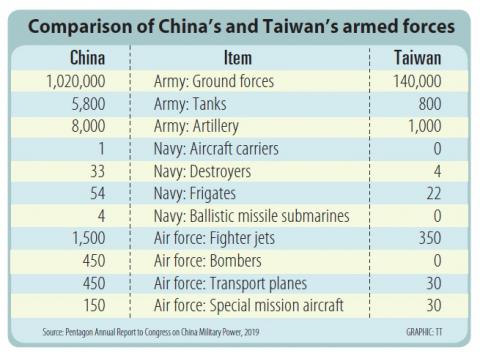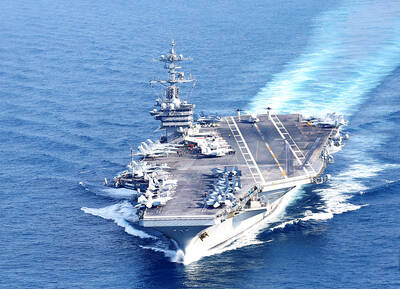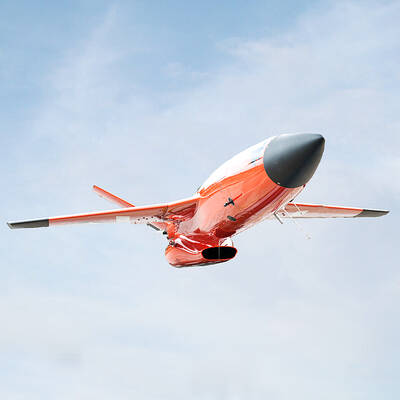Analysts and legislators urged the government to step up the nation’s asymmetric warfare capabilities, after the US Department of Defense issued a report on China’s military capabilities.
The report, released on Thursday, said that the west and northwest of Taiwan are in range of the People’s Liberation Army’s (PLA) air defense missiles, Institute of National Defense and Security Research analyst Su Tzu-yun (蘇紫雲) said.
The Ministry of National Defense’s decision to replace Northrop F-5Es at Chihhang Air Base in Taitung with F-16Vs is vindicated by the report’s findings, he said.

Basing Taiwan’s most advanced tactical aircraft at Chihhang would put them beyond the reach of Chinese surface-to-air missile fire during takeoff, Su said.
The military should also enhance its arsenal of surface-to-air and shore-based anti-ship missiles that, in conjunction with Japan’s anti-ship missile batteries at Miyakojima in Okinawa Prefecture, could block the PLA’s access to the Pacific from the first island chain, he said.
The report identified three possible forms of Chinese aggression toward Taiwan: large-scale missile attacks, limited attacks by precision-guided munitions or an amphibious assault, Chinese-language Military Link Magazine editor-in-chief Chen Wei-hao (陳維浩) said.
No nation has ever surrendered to missile attacks alone, so Beijing could well find that it has no alternative but to stage an amphibious assault if it wishes to bend Taiwan to its will, Chen said.
Mounting an amphibious invasion of Taiwan could be a daunting prospect for China, as such military action risks domestic stability and could lead to armed intervention by other states, he said.
While China is unlikely to achieve victory with missile fire alone, the improved range of its modern missiles poses a “huge threat,” as the military’s plans to escape missile fire by moving units east could be rendered obsolete, Chen said.
“The urgent task is conceiving a response that would actually implement the principles of asymmetric warfare, especially with regard to disrupting the communist forces’ ability to push supplies and reinforcements to the front,” he said.
Regarding the report’s conclusion that the PLA could commit its sole aircraft carrier to battle, Chen said the Liaoning has more propaganda than combat value.
Accounting for maintenance cycles, a minimum of three carriers is needed to make a strategic impact, Chen said.
Chinese naval aviation would not pose a serious threat for the next 10 to 15 years, he said.
Democratic Progressive Party Legislator Wang Ting-yu (王定宇) said the report suggests that the US’ armed forces are actively preparing to defend the region.
Taiwan’s military defenses are acceptable, but the military should keep improving the mobility of its units and therefore their survivability, he added.
Ministry spokesman Major General Chen Chung-chi (陳中吉) said that the nation’s armed forces continue to observe trends and exercise control over the airspace and maritime zones around the nation.
“The military will, as the president has said, yield not an inch of the nation’s sovereign territory or an iota of our freedoms and democracy,” he said.

CROSS-STRAIT COLLABORATION: The new KMT chairwoman expressed interest in meeting the Chinese president from the start, but she’ll have to pay to get in Beijing allegedly agreed to let Chinese Nationalist Party (KMT) Chairwoman Cheng Li-wun (鄭麗文) meet with Chinese President Xi Jinping (習近平) around the Lunar New Year holiday next year on three conditions, including that the KMT block Taiwan’s arms purchases, a source said yesterday. Cheng has expressed interest in meeting Xi since she won the KMT’s chairmanship election in October. A source, speaking on condition of anonymity, said a consensus on a meeting was allegedly reached after two KMT vice chairmen visited China’s Taiwan Affairs Office Director Song Tao (宋濤) in China last month. Beijing allegedly gave the KMT three conditions it had to

STAYING ALERT: China this week deployed its largest maritime show of force to date in the region, prompting concern in Taipei and Tokyo, which Beijing has brushed off Deterring conflict over Taiwan is a priority, the White House said in its National Security Strategy published yesterday, which also called on Japan and South Korea to increase their defense spending to help protect the first island chain. Taiwan is strategically positioned between Northeast and Southeast Asia, and provides direct access to the second island chain, with one-third of global shipping passing through the South China Sea, the report said. Given the implications for the US economy, along with Taiwan’s dominance in semiconductors, “deterring a conflict over Taiwan, ideally by preserving military overmatch, is a priority,” it said. However, the strategy also reiterated

‘BALANCE OF POWER’: Hegseth said that the US did not want to ‘strangle’ China, but to ensure that none of Washington’s allies would be vulnerable to military aggression Washington has no intention of changing the “status quo” in the Taiwan Strait, US Secretary of Defense Pete Hegseth said on Saturday, adding that one of the US military’s main priorities is to deter China “through strength, not through confrontation.” Speaking at the annual Reagan National Defense Forum in Simi Valley, California, Hegseth outlined the US Department of Defense’s priorities under US President Donald Trump. “First, defending the US homeland and our hemisphere. Second, deterring China through strength, not confrontation. Third, increased burden sharing for us, allies and partners. And fourth, supercharging the US defense industrial base,” he said. US-China relations under

The Chien Feng IV (勁蜂, Mighty Hornet) loitering munition is on track to enter flight tests next month in connection with potential adoption by Taiwanese and US armed forces, a government source said yesterday. The kamikaze drone, which boasts a range of 1,000km, debuted at the Taipei Aerospace and Defense Technology Exhibition in September, the official said on condition of anonymity. The Chungshan Institute of Science and Technology and US-based Kratos Defense jointly developed the platform by leveraging the engine and airframe of the latter’s MQM-178 Firejet target drone, they said. The uncrewed aerial vehicle is designed to utilize an artificial intelligence computer